Welcome to the world of structured yoga practices! A 60-minute yoga sequence offers a balanced approach to physical, mental, and emotional well-being. With tools like Yoga Sequence Builders and pre-designed lesson plans, creating a holistic practice is effortless. Whether you’re a beginner or an experienced yogi, this guide will help you craft a meaningful and transformative 60-minute practice.
Overview of the Importance of Structured Yoga Sequences
A well-structured yoga sequence is essential for a safe and effective practice. It ensures a logical flow, progressing from warm-up to peak poses and cooling down, which prevents injury and enhances benefits. Structured sequences, like those in a 60-minute yoga sequence PDF, provide clarity and focus, helping practitioners achieve specific goals, such as improving balance, flexibility, or strength. They also cater to different levels, offering modifications for beginners and challenges for advanced yogis. By following a structured plan, teachers can guide students through a holistic practice that integrates breath, movement, and mindfulness. This approach fosters consistency, progress, and a deeper connection to yoga’s transformative power.
Benefits of a 60-Minute Yoga Practice
A 60-minute yoga practice offers numerous benefits, enhancing physical, mental, and emotional well-being. It provides ample time for a comprehensive warm-up, deepening postures, and relaxation, leading to improved flexibility, strength, and balance. This duration allows for a meditative state, reducing stress and anxiety while boosting mood through endorphin release. Regular practice can enhance focus, energy levels, and overall vitality. It also supports detoxification through twists and inversions, promoting a sense of renewal. Additionally, a 60-minute sequence encourages mindfulness and self-awareness, fostering a deeper connection to one’s body and spirit. Consistency in this practice can lead to long-term health benefits, making it an ideal commitment for those seeking holistic wellness.
Key Components of a Balanced Yoga Class
A balanced yoga class typically includes a structured sequence of postures, breathing techniques, and relaxation. It begins with a warm-up to prepare the body, followed by flowing vinyasa sequences to build heat and strength. Standing postures enhance balance and stability, while seated poses focus on flexibility and alignment. Twists and inversions aid in detoxification and energy flow, and backbends open the chest and shoulders. The practice concludes with cooling stretches, Legs-Up-The-Wall Pose, and a meditative Savasana for deep relaxation. Pranayama and mindfulness are woven throughout to harmonize the body, mind, and breath. This holistic approach ensures a well-rounded practice, promoting physical, mental, and emotional well-being. Each component is thoughtfully integrated to create a transformative experience.
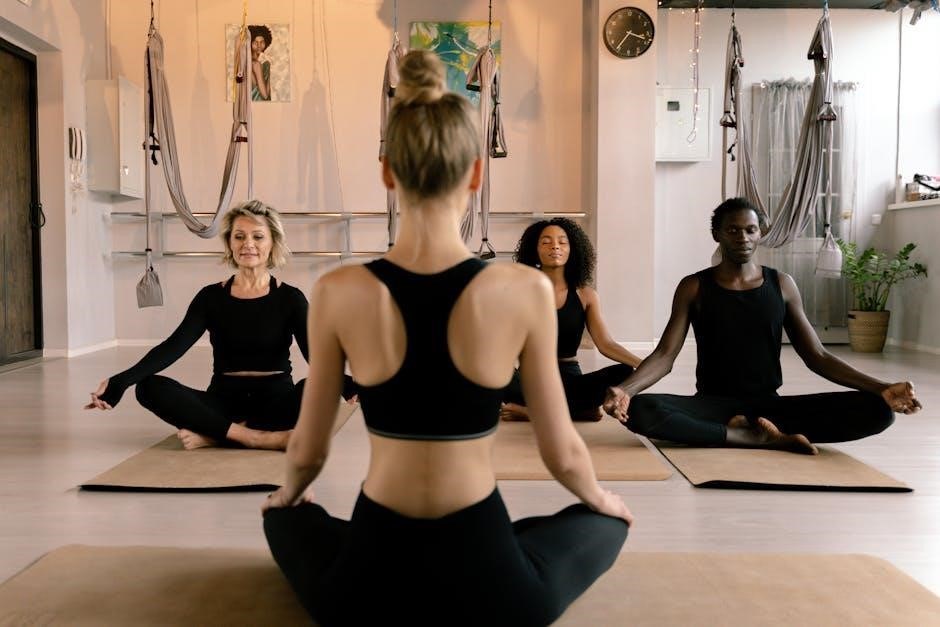
Preparing for the Practice
Creating a serene space, gathering essential props like blocks or straps, and selecting a suitable yoga style are key to a successful 60-minute practice.
Setting Up the Ideal Yoga Space
Creating a serene and functional yoga space is essential for a focused 60-minute practice. Begin by selecting a quiet, distraction-free area with a non-slip yoga mat as the foundation. Ensure the room is well-ventilated and maintained at a comfortable temperature. Natural light is ideal, but soft lighting can also create a calming ambiance. Gather essential props like blocks, straps, blankets, and a bolster to support various postures. Keep the space clutter-free to promote a sense of openness and mindfulness. Consider adding soothing elements such as calming music or incense to enhance the atmosphere. A well-prepared space helps you stay committed and present throughout your practice, allowing you to fully embrace the benefits of your 60-minute sequence.
Essential Props for a 60-Minute Sequence
Elevate your 60-minute yoga practice with the right props to ensure comfort, alignment, and accessibility. A high-quality yoga mat is essential for grip and cushioning. Blocks and straps help modify postures for all levels, making challenging poses attainable. Blankets can provide padding for sensitive joints or support for seated postures. A bolster is ideal for restorative yoga, offering deep relaxation and spinal support. Weighing these tools allows you to customize your practice, ensuring safety and effectiveness. Whether you’re a beginner or advanced, props empower you to embrace the full potential of your sequence, fostering a balanced and enriching experience.
Choosing the Right Yoga Style for the Sequence
Selecting the appropriate yoga style for your 60-minute sequence is crucial to achieve the desired benefits. Consider your goals, whether it’s strength, flexibility, relaxation, or balance. Vinyasa Flow is ideal for dynamic movement and cardiovascular benefits, while Hatha yoga focuses on foundational postures and breathing techniques. Yin yoga targets deep connective tissues for flexibility, and Restorative yoga emphasizes relaxation and rejuvenation. Iyengar yoga, with its emphasis on precise alignment and props, is excellent for therapeutic benefits. Ashtanga offers a challenging, fast-paced sequence for experienced practitioners. Choose a style that aligns with your experience level and objectives to create a fulfilling and well-rounded practice.
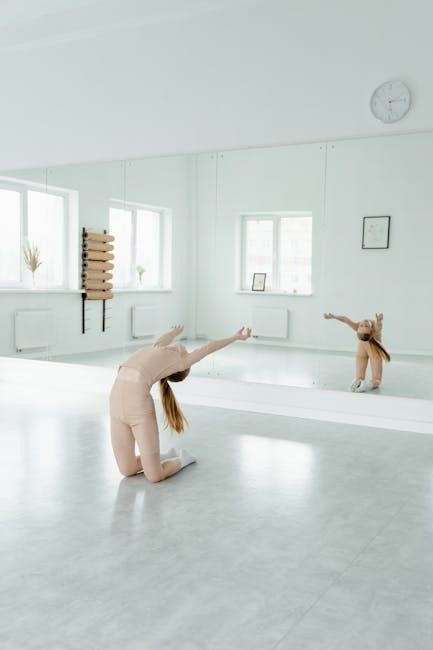
Breathing Techniques for the Sequence
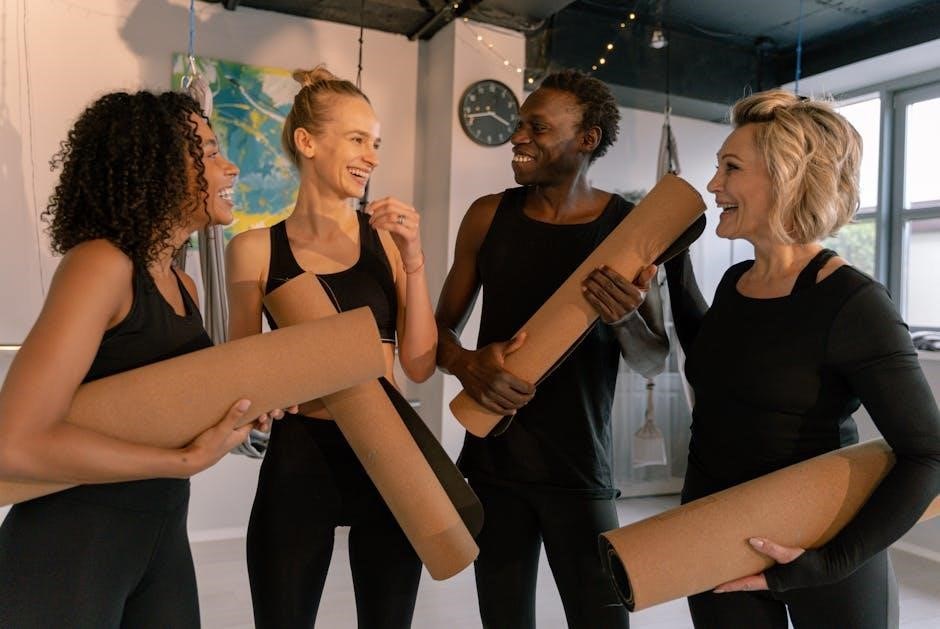
Breathing is the essence of yoga, linking body and mind. Techniques like Ujjayi and Alternate Nostril breathing enhance focus, balance, and energy flow, creating a meditative practice.
Pranayama, or yogic breathing, is a cornerstone of yoga practice. It involves conscious regulation of breath to harness life force energy. Techniques like Ujjayi, Bhramari, and Nadi Shodhana help calm the mind, balance the nervous system, and prepare the body for asana practice. Pranayama is often practiced at the beginning of a sequence to set intention and create a meditative state. Regular practice enhances respiratory efficiency, reduces stress, and improves overall well-being. Incorporating Pranayama into your 60-minute yoga sequence can deepen your practice, fostering a connection between breath, movement, and awareness. It is a powerful tool for transforming physical postures into a mindful, holistic experience.
Ujjayi Breath for Vinyasa Flow
Ujjayi, or “ocean breath,” is a foundational breathing technique in Vinyasa Flow yoga. It involves inhalation and exhalation through the nose with a slightly closed throat, creating a soft hissing sound. This breath is essential for linking movement with breath, fostering a meditative flow. During a 60-minute sequence, Ujjayi helps maintain rhythm, balance, and focus. It enhances endurance, allowing for smoother transitions between poses. Regular practice of Ujjayi improves respiratory control, calms the nervous system, and promotes relaxation. Incorporating this breath into your Vinyasa Flow practice deepens the connection between body and mind, making it a vital component of a well-rounded yoga sequence.
Alternate Nostril Breathing for Balance
Alternate Nostril Breathing, or Nadi Shodhana, is a powerful technique to balance the body’s energy and calm the mind. It involves closing one nostril with the finger and breathing through the other, then switching. This practice harmonizes the left and right energy channels, promoting equilibrium. Regular use of this breath in a 60-minute sequence enhances respiratory function, reduces stress, and improves focus. It prepares the body for deeper postures and meditation by creating a steady, balanced state. Incorporating Alternate Nostril Breathing into your practice fosters mental clarity and physical alignment, making it an essential element of a holistic yoga routine.
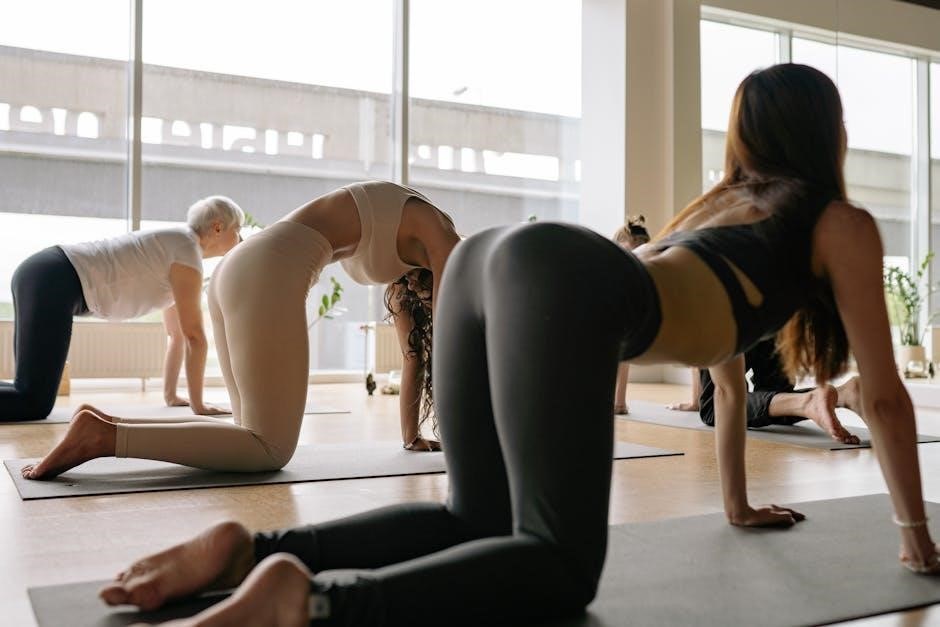
Warm-Up and Initial Sequence
A thoughtfully designed warm-up prepares the body and mind for practice, incorporating gentle movements, breath awareness, and foundational postures to set the tone for a balanced sequence.
5-Minute Opening Meditation
A 5-minute opening meditation sets the tone for a mindful practice, helping to calm the mind and center the body. This brief yet powerful segment allows practitioners to transition from daily stress to a state of awareness. By focusing on deep, rhythmic breathing and visualization techniques, individuals can quiet the mind and prepare for the physical and mental journey ahead. This meditation acts as a foundation, fostering intention and presence. It is an essential start to any structured yoga sequence, ensuring a holistic experience that unites body, breath, and consciousness. The internet offers various guided meditations and techniques to incorporate into this segment, making it accessible for all levels of practitioners.
Neck and Shoulder Release Exercises
Neck and shoulder release exercises are essential for relieving tension and improving flexibility. These gentle movements help ease common stress-induced stiffness, promoting relaxation. Techniques include slow, controlled rotations of the neck, shoulder shrugs, and ear-to-shoulder tilts. Incorporating breath awareness enhances the release process, allowing for deeper relaxation. These exercises prepare the upper body for more dynamic postures later in the sequence; They also improve posture and reduce the risk of injury. By addressing these critical areas, practitioners can move through the rest of their practice with greater ease and freedom. This segment is particularly beneficial for individuals with desk-based lifestyles or those carrying chronic tension in the neck and shoulders. Regular practice fosters long-term relief and overall well-being.
Warming Up the Spine and Hips
Warming up the spine and hips is crucial for preparing the body for a dynamic yoga practice. Gentle movements like Cat-Cow and spinal twists awaken the spine, improving flexibility and mobility. Sun Salutations are often used to warm up the entire body, incorporating flowing movements that engage the hips and spine. Standing poses such as Warrior I and II, along with Triangle Pose, further open the hips and strengthen the lower back. These exercises enhance circulation, reduce stiffness, and prepare the body for deeper postures later in the sequence. A well-structured warm-up ensures a safe and effective transition into more challenging movements, setting the foundation for a balanced and energizing practice. Regular spinal and hip warm-ups also promote long-term flexibility and joint health.
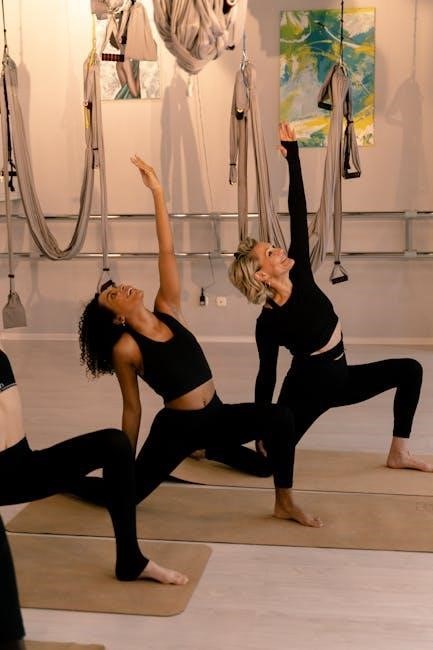
The Main Yoga Sequence
The main sequence combines flowing Vinyasa, standing postures, seated stretches, twists, and inversions. It builds strength, flexibility, and energy flow, creating a balanced and transformative practice experience.
Flowing Vinyasa Sequence (20 Minutes)
A 20-minute Vinyasa flow forms the dynamic core of the main sequence. It synchronizes breath with movement, linking poses like Sun Salutations, Warrior flows, and balancing postures. This segment builds internal heat, strength, and cardiovascular endurance, preparing the body for deeper stretches and holds. The continuous flow enhances flexibility and focus, creating a meditative rhythm. Proper alignment cues and modifications ensure safety and accessibility for all levels. This flowing segment is designed to elevate energy levels while fostering mindfulness and connection between body and breath, making it a cornerstone of the 60-minute practice.
Standing Postures for Strength and Balance
Standing postures are foundational for building strength, stability, and balance. Poses like Warrior II, Triangle Pose, and Tree Pose are essential, engaging the legs, core, and arms. These postures improve alignment, enhance focus, and prepare the body for more complex movements. Incorporating balance-enhancing poses such as Eagle Pose or Half Moon Pose challenges equilibrium and builds confidence. Proper engagement of the feet, knees, and hips is emphasized to prevent injury. Holding these postures for extended periods strengthens the muscles and cultivates mental resilience. Modifications are encouraged to accommodate all levels, ensuring a safe and effective practice. These standing postures are a powerful way to ground and empower the body, forming a strong base for the entire sequence.
Seated Postures for Flexibility and Alignment
Seated postures are ideal for enhancing flexibility and promoting proper alignment. Poses like Seated Forward Fold (Paschimottanasana) and Seated Spinal Twist (Bharadvajasana) target the hamstrings, hips, and spine, fostering deep stretches and improved mobility; These postures also encourage mindful breathing, helping to release tension and enhance overall posture. Modifications, such as using blocks or straps, ensure accessibility for all levels. By maintaining seated postures, practitioners can deepen their practice, improve circulation, and experience a sense of calm. These poses are particularly beneficial for those seeking to enhance flexibility without strain, making them a cornerstone of a balanced yoga sequence. Regular practice strengthens the connection between body and mind, promoting long-term wellness and alignment.
Twist and Detoxify the Body
Twisting postures are a powerful way to detoxify and rejuvenate the body. Poses like Seated Spinal Twist (Bharadvajasana) and Revolved Triangle Pose (Parivrtta Trikonasana) compress and release internal organs, stimulating digestion and lymphatic circulation. These twists help eliminate toxins, improve circulation, and enhance energy flow. Marichyasana (Seated Spinal Twist) and Ardha Matsyendrasana (Half Lord of the Fishes) are particularly effective for cleansing the abdominal organs and spine. Regular practice of twisting postures promotes a healthy, balanced body and mind. By incorporating these poses into your 60-minute sequence, you can experience the profound benefits of detoxification and improved overall well-being. Mindful breathing during twists amplifies their cleansing effects, making them a vital part of any holistic yoga practice.
Inversions and Backbends for Energy Flow
Inversions and backbends are dynamic poses that enhance energy flow and vitality in a 60-minute yoga sequence. Inversions, such as Adho Mukha Svanasana (Downward-Facing Dog) and Viparita Karani (Legs-Up-The-Wall Pose), invert the body, promoting blood circulation and balancing energy; Backbends like Urdhva Dhanurasana (Wheel Pose) and Setu Bandha Sarvangasana (Bridge Pose) open the chest and spine, fostering confidence and inner strength. These poses stimulate the nervous system, improve posture, and energize the body. Incorporating them into your practice can leave you feeling refreshed and invigorated, while also deepening your connection to breath and movement. By combining inversions and backbends, you create a harmonious flow that elevates both physical and mental energy.

Cool Down and Final Relaxation
The final phase transitions to calming postures, preparing the body for deep relaxation. Legs-Up-The-Wall Pose and Savasana promote nervous system relaxation, rejuvenating the mind and body. Essential for unwinding after the sequence.
Transitioning to Calmer Postures
Transitioning to calmer postures is essential for gradually slowing down the nervous system after an intense practice. Begin by moving into gentle, grounding poses such as Child’s Pose or Seated Forward Fold, allowing the body to release tension. Incorporate deep, conscious breathing to enhance relaxation and prepare for the final stages of the sequence. This phase, lasting 5-10 minutes, helps students shift from active movement to a more meditative state. Guide participants to focus on their breath, letting go of physical and mental strain with each exhale. Proper transitions ensure a smooth flow into deeper relaxation, making this phase crucial for the overall benefits of the practice. It sets the stage for the final relaxation poses, such as Legs-Up-The-Wall Pose and Savasana, fostering a sense of calm and renewal.
Deep Stretching for Muscle Release
Deep stretching is a vital component of a 60-minute yoga sequence, focusing on releasing tension in the muscles and enhancing flexibility. Dedicate 10 minutes to poses that target key areas such as the hamstrings, hips, and lower back. Begin with Seated Forward Fold (Paschimottanasana) to stretch the entire back side of the body. Transition into Sphinx Pose (Salamba Bhujangasana) to gently open the chest and shoulders. Incorporate Pigeon Pose (Eka Pada Rajakapotasana) to release deep hip tension. Use props like blocks or straps to support deeper stretches safely. Encourage slow, controlled movements and deep breathing to maximize relaxation and release. This phase prepares the body for final relaxation, promoting a sense of calm and rejuvenation. Proper alignment and breath awareness are key to ensuring a safe and effective stretching practice.
Legs-Up-The-Wall Pose (Viparita Karani)
Legs-Up-The-Wall Pose, or Viparita Karani, is a restorative posture that promotes deep relaxation and rejuvenation. Ideal for the cool-down phase, this pose is held for 5-10 minutes to allow the body to fully release tension. Elevate your legs against a wall, with your hips and knees at a 90-degree angle, while lying comfortably on your back. Use a bolster or pillow under the lower back for support. This pose helps reduce swelling in the legs, calms the nervous system, and prepares the body for final relaxation. Focus on deep, rhythmic breathing to enhance the calming effects. It’s a simple yet powerful way to transition into a meditative state, making it a perfect addition to your 60-minute yoga sequence.

5-Minute Savasana for Deep Relaxation
The 5-Minute Savasana, or corpse pose, is a transformative conclusion to your 60-minute yoga practice. Lie on your back with arms and legs relaxed, eyes closed, and breathe deeply. This pose calms the nervous system, reduces stress, and promotes mindfulness. Use a blanket or bolster under the knees or neck for comfort. Focus on releasing tension in every muscle, allowing your body to surrender completely. As you rest, bring awareness to your breath, observing its natural rhythm without control. Savasana is not just relaxation—it’s a practice of letting go and reconnecting with your inner self. End your sequence here to seal in the benefits of your practice and leave feeling refreshed and centered. This pose is essential for balancing the energy cultivated during the sequence.

Additional Tips and Safety Guidelines
Always modify poses to suit your level, use props for support, and listen to your body. Prioritize breath awareness and alignment. Practice mindfully to enhance safety and benefits.
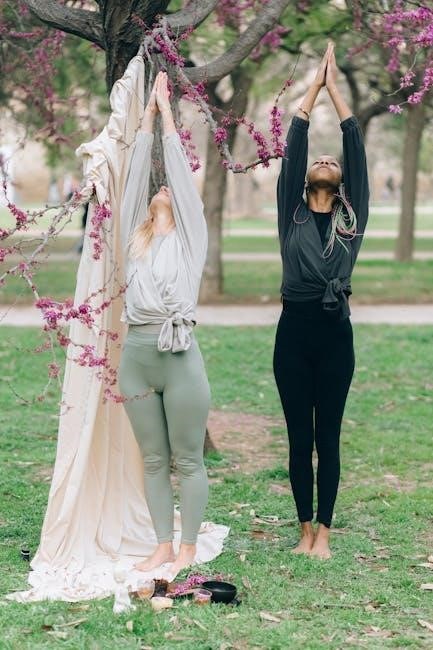
Modifications for Different Yoga Levels
Modifications are essential to make yoga accessible for all levels. For beginners, use props like blocks, straps, or blankets to support poses. Intermediate practitioners can deepen stretches or hold poses longer. Advanced yogis might explore complex postures or prolonged holds. Always offer alternatives to accommodate physical limitations or injuries. For example, replace headstands with Legs-Up-The-Wall Pose or modify deep twists with gentle seated options. Encourage students to honor their bodies by resting or using props when needed. Teachers should provide clear cues and demonstrations for modifications, ensuring a safe and inclusive practice. This approach fosters a supportive environment where everyone can benefit from the sequence, regardless of their yoga experience or physical abilities.
Using Props to Enhance the Practice
Props are invaluable tools to enhance your yoga practice, ensuring safety and accessibility. Blocks, straps, and blankets can help modify poses to suit individual needs, while bolsters and wheels support deeper relaxation or improve alignment. For example, a block can bridge the gap between hands and mat in Standing Forward Bend, or a strap can extend reach in Seated Forward Bend. Blankets provide cushioning for joints, making seated postures more comfortable. Bolsters are perfect for supported backbends or restorative poses, promoting relaxation. Yoga wheels can aid in opening the chest or improving form in challenging postures. By incorporating props, you can tailor the practice to your body, making it more enjoyable and beneficial for all levels. This ensures a safe and transformative experience within the 60-minute sequence.
Listening to Your Body During the Sequence
Listening to your body is essential for a safe and effective yoga practice. Honor your physical sensations and limitations, as they guide your movement and breath. Pain or discomfort signals a need to modify or rest. Trust your intuition to slow down or pause when necessary. Each body is unique, and flexibility or strength varies daily. Embrace this variability by choosing poses that feel nurturing rather than forcing into uncomfortable positions. Rest when needed and use props to support your practice. Prioritize awareness over perfection, allowing your body to dictate the rhythm of your sequence. This mindful approach fosters a deeper connection with your inner self, ensuring a practice that nourishes both body and soul while promoting long-term well-being and empowerment.
A 60-minute yoga sequence is a transformative practice fostering balance, strength, and mental calm. Embrace consistency, stay mindful, and let each session nourish your body and soul deeply.
Importance of Consistency in Yoga Practice
Consistency is the cornerstone of a transformative yoga journey. Regular practice, even for 60 minutes, fosters physical strength, mental clarity, and emotional resilience. Over time, it deepens your connection with your body and breath, enhancing overall well-being. Commitment to a daily or weekly routine ensures steady progress, allowing you to build upon each session. Whether you’re aiming to improve flexibility, balance, or reduce stress, consistency is key to unlocking yoga’s full potential. It cultivates discipline, mindfulness, and self-awareness, empowering you to embrace challenges on and off the mat. By prioritizing regular practice, you invest in a healthier, more balanced lifestyle.
Encouraging a Mindful and Meditative State
A 60-minute yoga sequence is an ideal opportunity to cultivate mindfulness and meditation. Begin with an intention or mantra to set a purposeful tone, fostering presence throughout the practice. Incorporate moments of stillness, such as an opening meditation or pauses between postures, to allow the mind to settle. Techniques like Ujjayi breathing and focused drishti (gaze) help maintain concentration and calm. As the sequence progresses, guide the flow to include both dynamic and calming postures, ensuring a natural transition into deeper relaxation. End with a prolonged Savasana, encouraging surrender and inner reflection. Consistency in these practices strengthens the mind-body connection, promoting a meditative state that extends beyond the mat into daily life. This structured approach nurtures mindfulness, making it a powerful tool for mental and emotional well-being.
Final Words on the Benefits of a 60-Minute Sequence
A 60-minute yoga sequence offers profound benefits for the body, mind, and spirit. By dedicating a full hour to practice, you cultivate consistency, which is key to progressing in yoga. This extended time allows for a balanced flow, combining dynamic movement with deep relaxation, ensuring comprehensive physical and mental rejuvenation. Regular practice enhances strength, flexibility, and cardiovascular health while reducing stress and improving mental clarity. The structured format of a 60-minute sequence also fosters discipline and mindfulness, encouraging a deeper connection to your inner self. Over time, this practice becomes a powerful tool for holistic well-being, transforming not just your body but also your approach to life. Embrace this journey and experience the transformative power of a well-crafted 60-minute yoga sequence.